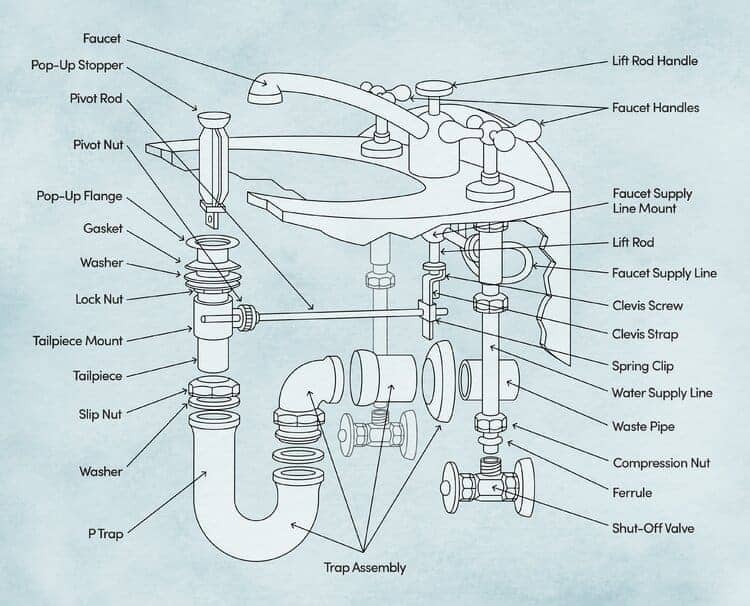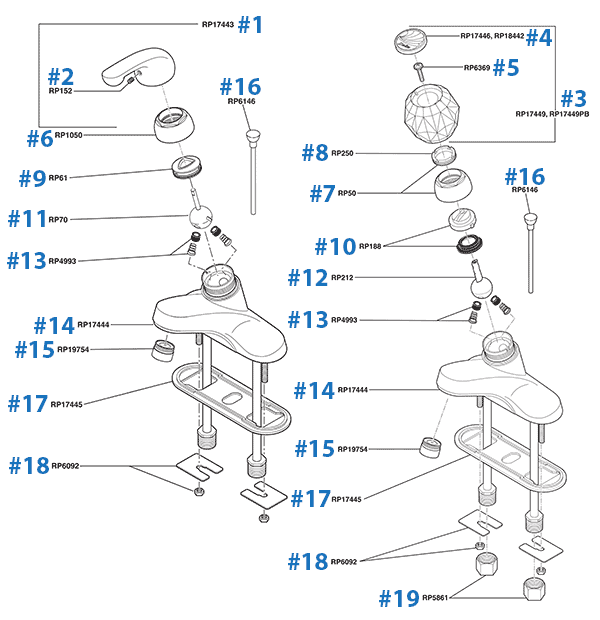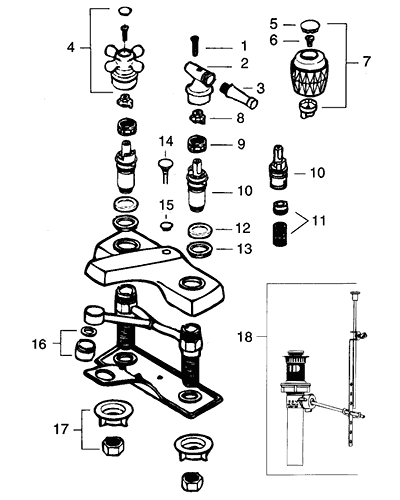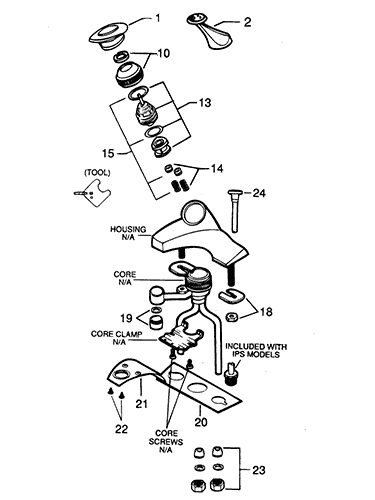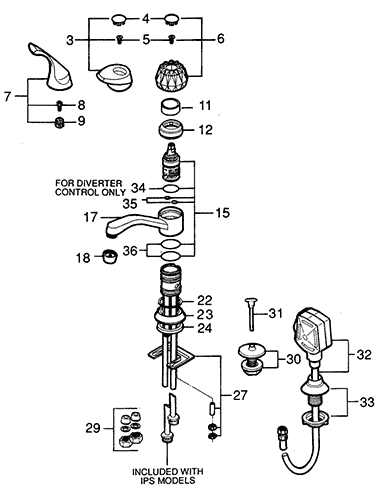Exploring the inner workings of a bathroom sink faucet can be a fascinating journey. In this comprehensive breakdown, we’ll delve into the intricate world of bathroom sink faucet parts and their functions.
The Handle and Valve: At the forefront of the faucet’s design is the handle. It’s the first point of contact for users and is connected to a valve mechanism. The valve controls the flow of water by regulating the opening and closing of a rubber or ceramic disc. When you turn the handle, it moves the disc, allowing water to flow or shutting it off completely. This is where you have the choice between single-handle and double-handle faucets, with the former offering convenience and modern aesthetics, while the latter allows more precise control over water temperature.
Spout Assembly: The spout is a key component responsible for directing water from the source to the sink. It typically consists of an aerator, a pipe, and a decorative outer shell. The aerator’s job is to mix air with the water, reducing splashing and conserving water while maintaining adequate water pressure. The pipe connects the valve to the spout, and the decorative shell adds an aesthetic touch to the faucet’s overall design. The spout’s height and reach can vary, affecting its functionality. Higher spouts provide more space for filling large containers, while shorter ones are more suitable for smaller sinks.
Pop-Up Drain Assembly: Often overlooked but crucial to the sink’s function is the pop-up drain assembly. This includes the drain stopper, lift rod, and drainpipe. The lift rod, connected to the faucet handle, controls the stopper’s movement. When you pull up on the handle, the stopper seals the drain, allowing you to fill the sink. Pushing the handle down opens the drain and lets the water flow out. The drainpipe connects the sink’s drain to the wastewater system. Proper installation and maintenance of the pop-up drain assembly are essential to prevent leaks and ensure efficient drainage.
A bathroom sink faucet is more than just a point of water access; it’s a marvel of engineering and design. Understanding its components, such as the handle and valve, spout assembly, and pop-up drain assembly, can help you make informed choices when it comes to installation, maintenance, and upgrades. Whether you’re looking for a sleek and modern design or a classic, elegant faucet, knowing how these parts work together will ensure that your bathroom sink faucet not only serves its purpose but also adds style to your space.
Valley Two Handle Bathroom Faucet Repair Parts
Rv Bathroom Sink Faucet Check more at http://s2pvintage.com/22334
Valley Single Handle Bathroom Faucet Repair Parts
Parts of a Sink
Replacement Parts for Widespread Lavatory Faucet with Cross Handle
American Standard Sink Faucet Parts American Standard Bathroom
Valley Single Handle Bathroom Faucet Repair Parts
Related articles:
- Bathroom Sink Cabinets Modern
- Rustic Bathroom Sink Ideas
- Bathroom Sink Storage Ideas
- Farmhouse Bathroom Sink Ideas
- Bathroom Sinks Blue
- Bathroom Sink 400mm
- Ada Bathroom Sink Dimensions
- Bathroom Sink Marble Countertop
- Bathroom Sink Design Ideas
- Bathroom Sink Pipe Leak Repair
Bathroom Sink Faucet Parts Diagram: A Comprehensive Guide
One of the most important parts of any bathroom is the sink faucet. It is not only a functional item, but one that can also make or break the design of the room. Knowing the different types of sink faucet parts, and how they fit together, is essential for any homeowner wanting to upgrade or replace their existing fixtures. In this guide, we’ll look at a bathroom sink faucet parts diagram and explore each component in detail.
Types of Bathroom Sink Faucets
The two main types of bathroom sink faucets are center-set and single-hole faucets. Center-set faucets come with three pieces; a spout, two handles, and a base plate. The spout and handles are usually mounted on a single base plate for easy installation. Single-hole faucets only have one handle and one spout and are often more modern in design.
Components of a Bathroom Sink Faucet
Below is a bathroom sink faucet parts diagram detailing the components of both center-set and single-hole faucets.
Figure 1: Bathroom Sink Faucet Parts Diagram
1. Spout: This is the part of the faucet that comes out from the wall and directs water into the basin or bathtub. Depending on the type of spout, it may swivel or rotate to direct water in different directions or provide more reach when filling containers like buckets or kettles.
2. Handles: There are two types of handles; lever handles which operate with a lever up and down motion, and knob handles which turn clockwise to open and counterclockwise to close. Handles can also be configured to operate both hot and cold water valves at once, or as separate valves for individual control over water temperature.
3. Escutcheon Plate/Base Plate: This is what holds the spout and handles in place on the wall or deck. It also helps to conceal any mounting holes from view for a neat finish around the sink area. Escutcheon plates come in various shapes such as round, square, oval, rectangle, octagon etc., depending on the design of your faucet.
4. O-rings: O-rings help create an airtight seal between the spout and handle body as well as between each handle base and its respective valve base to prevent water from leaking out (Figure 2). They are usually made from rubber or plastic materials that help keep your faucet leak free for many years to come!
Figure 2: O-Rings Diagram
5. Valves: Valves are responsible for controlling water flow through your faucet’s handles by either opening or closing them off completely when desired (Figure 3). There are two main types; ceramic disc valves that last longer than traditional ball valves but require more effort to turn them on/off, and cartridges that provide greater control over water flow but need to be replaced more often than other valve types due to wear and tear over time.
Figure 3: Valve Diagram
6. Aerators: Aerators are small nozzles that attach onto your spout’s outlet end which help break up large streams of water into smaller droplets (Figure 4). This helps reduce splashing while making sure you still get enough pressure for filling containers quickly with minimal waste!
Figure 4: Aerator Diagram
7. Shutoff Valves: Shutoff valves are located behind your wall or under your sink cabinet (Figure 5). They act as an emergency stop button when needed by turning off all water supply instantly so you can repair any leaks without having to shut off your main water supply line from outside your home!
Figure 5: Shutoff Valve Diagram
FAQs about Bathroom Sink Faucets Parts Diagrams
Q1: What type of faucets do I have?
A1: To determine what type of faucets you have, you Will need to look at the parts diagram. Center-set faucets come with three pieces, a spout, two handles, and a base plate. Single-hole faucets only have one handle and one spout.
Q2: What are O-rings used for?
A2: O-rings are used to create an airtight seal between the spout and handle body as well as between each handle base and its respective valve base to prevent water from leaking out. They are usually made from rubber or plastic materials that help keep your faucet leak free for many years to come.
Q3: What is an aerator?
A3: An aerator is a small nozzle that attaches onto your spout’s outlet end which helps break up large streams of water into smaller droplets. This helps reduce splashing while making sure you still get enough pressure for filling containers quickly with minimal waste!
What are the different types of bathroom sink faucet parts?
1. Handles: Handles are the most visible part of a faucet and are used to turn the water on and off.
2. Spout: The spout is the curved pipe that directs water from the faucet to the sink.
3. Escutcheons: An escutcheon is a metal or plastic plate that fits around the base of a faucet, covering any gaps or holes in the countertop.
4. Aerator: An aerator is a small device that attaches to the end of a faucet and mixes air with water to help conserve water and reduce splashing from the faucet.
5. Pop-up waste: A pop-up waste is a device that sits in the sink drain and allows you to open or close the drain with a handle or lever.
6. Supply lines: Supply lines connect the sink faucet to the water supply pipes in your home, carrying hot and cold water to your sink.
